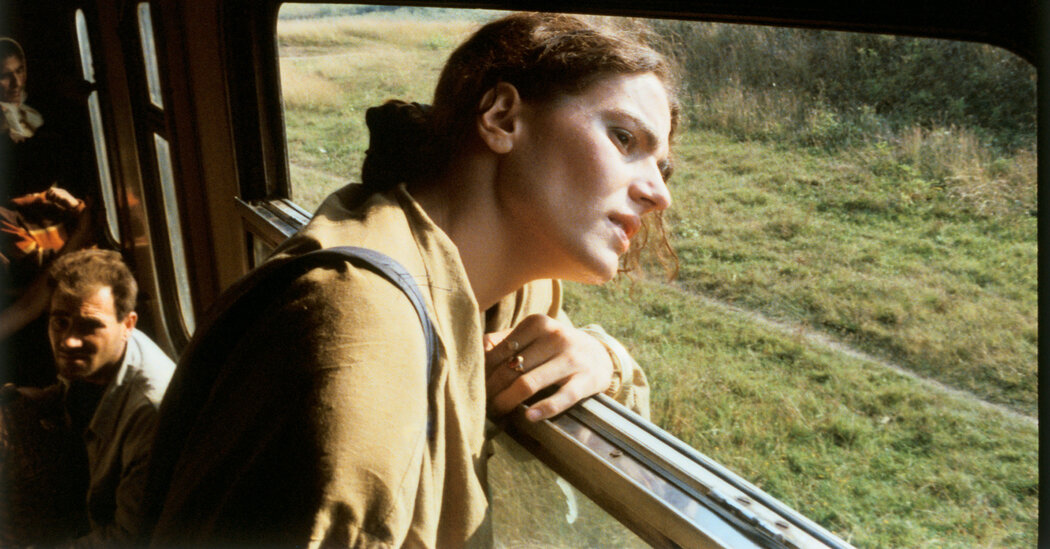
Playing the last days of Romanian communism as frenzied farce, Lucian Pintilie’s “The Oak” is set in a world so despoiled a Hieronymus Bosch landscape might seem bucolic by comparison.
First shown in 1992, some three years after the dictator Nicolae Ceausescu and his wife were executed and a year after a new constitution replaced single-party rule, “The Oak” has been restored and revived for a week at Film Forum. Ensuing decades have scarcely mitigated its power.
Following the death of her father, a onetime colonel in the secret police, the disheveled and seemingly demented Nela (Maia Morgenstern) departs the squalid Bucharest apartment they shared and, carrying dad’s ashes in a jar of Nescafé, makes her way to Copsa Mica, the Transylvanian town where she has been hired to teach.
The place is a citadel of pollution — industrial and otherwise. Nela is sexually assaulted by a gang of drunken workers. After she is dumped in a hospital bed (its previous occupant unceremoniously relocated to the floor), Nela meets a kindred soul in Mitica (Razvan Vasilescu), a surgeon similarly sent to the Transylvanian back of beyond. Equally unrestrained, Mitica eschews bribes and physically attacks his superiors, often with a fixed grin. The pair team up in a scattershot, anti-authoritarian conspiracy of two.
As wildly impulsive Nela, Morgenstern gives a performance no less anarchic than the movie. (It’s a minor irony of cinema history that this whirlwind actress would be best known for her somber portrayal of Jesus’s mother in “The Passion of the Christ.”) She’s so much fun to watch that “The Oak” loses velocity when attention shifts to her cohort.
Punctuated with sudden explosions, random mayhem, yelling, cursing, and ringing telephones, “The Oak” is impossibly busy as well as incredibly bleak. Trains stall, bridges flood, trucks crash. The army is perpetually holding drills. The hospital doubles as a charnel house. Officials are ineffectual even in their self-dealing. Ordinary people are pointlessly bellicose.
The movie is sometimes exhausting but never dull. Indeed, the pace is dizzying to the point of disorientation. “You can’t be sure which way is up,” Vincent Canby wrote in his review in The Times, watching “The Oak” was like exploring “a house of horrors in an amusement park in space.”
Pintilie, who died in 2018, has been called the godfather of the Romanian new wave — an example for the talented young directors who emerged in the early 20th century. “The Oak” provided a template for the journey-to-the-end-of-the-night absurdism found in Cristi Puiu’s “The Death of Mr. Lazarescu” (2005) and Cristian Mungiu’s “4 Months, 3 Weeks and 2 Days” (2007). In addition, “The Oak” pioneered a mode that might be called post-Communist grotesque, anticipating the Balkan tumult of the Serbian filmmaker Emir Kusturica’s “Underground” (1995), the frantic labyrinthine surrealism of Aleksei German’s “Khrustalyov, My Car!” (1998) and the political slapstick of Armando Iannucci’s “The Death of Stalin” (2017).
Unlike those three films however, “The Oak” has the quality of a personal exorcism. Made upon Pintilie’s return to Romania after years of self-imposed exile, it is a work of bottled-up fury. The movie’s mad energy suggests that Pintilie, some of whose earlier films were personally banned by Ceausescu, is pounding a stake through the dictator’s heart the better to dance on his grave.
The Oak
April 28 through May 4 at Film Forum in Manhattan, filmforum.org.













